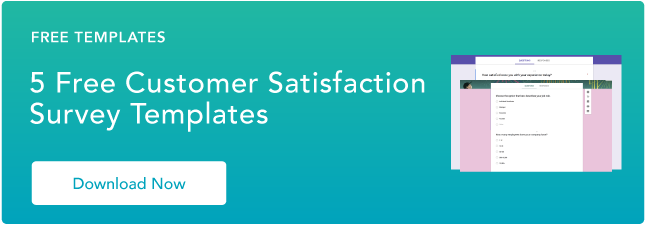You know thatcustomer feedbackis important. You know that, in order to evaluate the happiness and loyalty of your customers, you need to know what they trulythinkabout your product or service.

So, how do you get those insights? A customer survey.
Once you know how tocreate a survey, you might be wondering what types of questions you should ask. The first question is one you need to answer -- what information are you trying to find out?
Once you know the answer to that question, you can start writing your own survey questions.
How to Write a Survey
The best surveys are simple, concise, and organized in a logical order. They contain a user-friendly balance of short-answer and multiple-choice questions that derive specific information from the participant. Additionally, most questions should be optional and framed in a manner that avoids any bias.
Picking the right questions can be difficult because you want to make sure your survey contains an even balance of different question types.
Keep reading this blog post to learn about different survey questions types, what information they can tell you, and examples of each -- along with some hard and fast best practices to follow.
Types of Survey Questions
- Multiple Choice
- Rating Scale
- Likert Scale
- Ranking
- Semantic Differential
- Dichotomous
- Close-Ended
- Open-Ended
1. Multiple Choice
Multiple choice survey questions are questions that offer respondents a variety of different responses to choose from. These questions are usually accompanied by an "other" option that the respondent can fill in with a customer answer if the options don't apply to them.
Multiple choice survey questions among the most popular types of survey questions because they're easy for respondents to fill out, and the results produce clean data that's easy to break out and analyze. Ask multiple-choice questions to learn about your customers' demographic information, product or service usage, and consumer priorities.
Single-Answer
Single-answer multiple choice questions only allow respondents to select one answer from a list of options. These frequently appear online as circular buttons respondents can click.
Multiple-Answer
Multiple-answer multiple choice questions allow respondents to select all responses that apply from a list of options. These frequently appear as checkboxes respondents can select.
2. Rating Scale
Rating scale questions (also known as ordinal questions) ask respondents to rate something on a numerical scale assigned to sentiment. The question might ask respondents to rate satisfaction or happiness on a scale of 1-10, and indicate which number is assigned to positive and negative sentiment.
Rating scale survey questions are helpful to measure progress over time. If you send the same group a rating scale several times throughout a time period, you can measure if the sentiment is trending positive or negative.
Use rating scale questions to gauge your company's Net Promoter Score® (NPS), an example of a common rating scale survey question.
3. Likert Scale
Likert scale survey questions evaluate if a respondent agrees or disagrees with a question. Usually appearing on a five or seven-point scale, the scale might range from "not at all likely" to "highly likely," or "strongly disagree" to "strongly agree."
Use Likert scale questions to evaluatecustomer satisfaction.
4. Ranking
Ranking survey questions ask respondents to rank a variety of different answer options in terms of relative priority or importance to them. Ranking questions provide qualitative feedback about the pool of respondents, but they don't offer the "why" behind the respondents' choice.
Use ranking questions to learn about customer needs and behavior to analyze how they're using your product or service, and what needs they might still have that your product doesn't serve.
5. Semantic Differential
Semantic differential survey questions also ask for respondents to rate something on a scale, but each end of the scale is a different, opposing statement. So, instead of answering the question "Do you agree or disagree with X?" respondents must answer questions about how something makes them feel or is perceived to them.
For example, a semantic differential question might ask, "On a scale of 1 to 5, how would you evaluate the service you received?" with 1 being "terrible" and 5 being "exceptional." These questions are all about evaluating respondents intuitive responses, but they can be tougher to evaluate than more cut-and-dry responses, like agreement or disagreement.
Use semantic differential questions to get clear-cut qualitative feedback from your customers.
Likert Scale vs. Semantic Differential
李克特量表和语义微分questions are asked on a scale respondents have to evaluate, but the difference lies in how the questions are asked. With Likert scale survey questions, respondents are presented with a statement they must agree or disagree with. With semantic differential survey questions, respondents are asked to complete a sentence, with each end of the scale consisting of different and opposing words or phrases.
6. Dichotomous
Dichotomous survey questions offer only two responses that respondents must choose between. These questions are quick and easy for the respondents to answer and for you to analyze, but they don't leave much room for interpretation, either.
Use dichotomous questions to get more clear-cut data that's quick and simple to analyze.
7.Close-Ended
Close ended survey questions are questions that have a set number of answers that respondents must choose from. All of the questions above are examples of close-ended survey questions. Whether the choices are multiple or only two, close-ended questions must be answered from a set of options provided by the survey creator.
8. Open-Ended
Where the survey types above all have closed-ended answers that you input as different options to choose from, open-ended questions are usually accompanied by an empty text box, where the respondent can write a customer answer to the question.
This qualitative feedback can be incredibly helpful to understand and interpret customer sentiment and challenges, but it isn't the easiest data to interpret if you want to analyze trends or changes in opinions. You need humans to interpret qualitative feedback to analyze for sentiment, tone, or spelling errors.
We suggest including open-ended questions alongside at least one other closed-ended question to collect data you can analyze and forecast over time, as well as those valuable qualitative insights straight from the horse's mouth.
Survey Question Examples
1. Multiple Choice
Here's an example of asingle-answermultiple choice question:

Here's an example of amultiple-answermultiple choice question:

2. Rating Scale
Here's an example of a rating scale survey question in a frequently-used format: NPS.

3. Likert Scale
Here's an example of afive-pointLikert scale:

Here's an example of aseven-pointLikert scale:

4. Ranking
Here's an example of a ranking survey question:

5. Semantic Differential
Here are examples of semantic differential survey questions:

6. Dichotomous
Here's an example of a dichotomous survey question:

7.Close-Ended
Here's an example of a close-ended, multiple-choice survey question:

8. Open-Ended
Here's an example of an open-ended question you might include in a survey:

How to Write Survey Questions
- Write unbiased survey questions.
- Don't write loaded questions.
- Keep survey question phrasing neutral.
- Don't use jargon.
- Avoid double negatives.
- Don't write double-barreled questions.
- 鼓励受访者回答所有的问题。
- Always provide an alternative answer.
- Keep questions clear and concise.
- Test your survey.
1. Write unbiased survey questions.
Leading survey questions are questions that suggest what answer the respondent should select. Here's an example of a leading survey question:
"What's your favorite tool that HubSpot offers?"
This is a leading question because the survey respondent might not like using HubSpot, so a list of different software tools might not accurately reflect the true answer. This question could be improved by offering an answer that allows the respondent to not have a favorite tool.
These questions aren't objective, and will lead your respondents to answer a question in a certain way based solely on the wording of the question, making the results unreliable. To avoid this, keep survey questions clear and concise, leaving you little room to lead respondents to your preferred answer, or have someone unfamiliar with the survey or subject matter review it and get their feedback.
2. Don't write loaded questions.
沿着same lines, loaded questions force survey respondents to choose an answer that doesn't reflect their opinion, thereby making your data unreliable. Here's an example of a loaded question:
"Where do you enjoy watching sports games?"
This is a loaded question because the respondent might not watch sports games. The survey question would need to include an answer option along the lines of "I don't watch sports games" in order to be objective.
Loaded questions typically contain emotionally charged assumptions that can push a respondent toward answering in a specific way. Remove the emotion from your survey questions by keeping them (mostly) free of adjectives.
3. Keep survey question phrasing neutral.
你知道他们说什么假设。不建立assumptions about what the respondent knows or thinks into the questions -- rather, include details or additional information for them. Here's an example of a question based on assumptions:
"What brand of laptop computer do you own?"
This question assumes the respondent owns a laptop computer, when they could be responding to the survey via phone or a shared device.So, to amend the example question above, the answer options would have to include "I don't own a laptop computer" to avoid assumptions.
Instead, keep question phrasing neutral, and leave different options to account for variability in your survey respondents.
4. Don't use jargon.
Jargon can make respondents feel unintelligent. Use clear, straightforward language that doesn't require a respondent to consult a dictionary. Here's an example of a jargon-y survey question:
"What's your CAC:LTV ratio?"
This survey question assumes the respondent is familiar with both acronyms, as well as the ratio as a business metric, which may not be the case.If your survey question includes acronyms, abbreviations, or any words specific to your lexicon, simplify it to ensure greater understanding. This survey question should unpack the definitions of these terms, and provide an answer option that accounts for the respondent not having that data on hand.
5. Avoid double negatives.
Double negatives are confusing, and they irritate respondents -- possibly to the point of not wanting to complete your survey. Here's an example of a survey question that includes a double negative, or two sentiments that contradict themselves:
"Do you not like using Google?"
Instead, the survey question should be phrased as "Do you like using Google?" so the meaning is crystal-clear.
These questions also make it tough for you to analyze the results when you get the survey back, too. Think about it: How can you know which statement the respondent is agreeing to if the question is structured confusingly?
6. Don't write double-barreled questions.
Double-barreled survey questions ask two questions at once. If you present two questions at the same time, respondents won't know which one to answer -- and your results will be misleading. Here's an example of a double-barreled survey question:
"Are you satisfied or unsatisfied with your compensation and career growth at your current employer?"
If the respondent is happy with their compensation, but unhappy with their career growth, they won't know if they should select "Satisfied" or "Unsatisfied" as their answer.
Instead, ask these distinct thoughts in the format of two distinct survey questions. That way, respondents won't be confused, and resulting data will be clear for you.
7.鼓励受访者回答所有的问题。
You're taking a survey to get people's opinions and it's tough when they provide you with something like "No comment," or "Not relevant," for an answer. To avoid this, supply the participant with answer options that account for every possibility to reflect the best possible information. Use a more specific answer option, like "I'm not sure," to give you a better idea of your survey base.
8. Always provide an alternative answer.
The goal of your survey should be toobtain customer feedback. However, you don't want this process to come at the expense of your customers' comfort. When asking questions, be sure to include a "I prefer not to answer this question," option. While you'll forfeit the answer, customers won't feel forced to give up sensitive information.
The other benefit of including this option is that you can measure your ability to write a survey. If customers are continuous leaving questions blank, you'll know it's the phrasing or structure of your survey. You can then reassess your survey's layout and optimize it for engagement.
9. Keep questions clear and concise.
The best surveys are short and take only a few minutes to complete. In fact,studiesshow that your completion rate can drop up to 20% if your survey takes more than seven or eight minutes to finish. That's because customers have busy schedules and will be more interested in your survey if it's shorter time commitment.
10. Test your survey.
Testing your questions is one of the best ways to see whether or not your survey is effective with yourcustomer base. You can release early versions of your survey to see how participants react to your questions. If you have low engagement or poor feedback, you can tweak your survey and correct user roadblocks. That way, you can make sure your survey is perfect before it’s sent to all of your stakeholders.
To learn more, read everything you need to know aboutquestionnairesnext.
Net Promoter, Net Promoter System, Net Promoter Score, NPS and the NPS-related emoticons are registered trademarks of Bain & Company, Inc., Fred Reichheld and Satmetrix Systems, Inc.


![→ Free Download: 5 Customer Survey Templates [Access Now]](https://no-cache.hubspot.com/cta/default/53/9d36416b-3b0d-470c-a707-269296bb8683.png)


![Leading Questions: What They Are & Why They Matter [+ 7 Examples]](http://www.eigoj.com/hubfs/leading%20questions_featured.jpg)






![How to Write a Survey Introduction [+Examples]](http://www.eigoj.com/hubfs/survey-introduction.jpg)